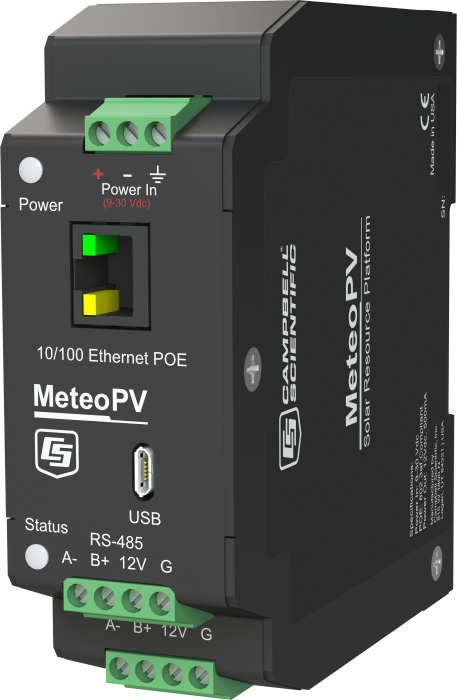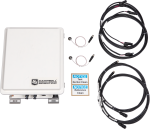Overview
The MeteoPV is a purpose-built photovoltaic (PV) resource data platform, ideal for distributed PV monitoring and functioning as a plane-of-array (POA), albedo, and soiling secondary weather station. As an easy-to-use sunstation solution, the MeteoPV has the flexibility to communicate with smart pyranometers, reference cells, back-of-module temperature sensors, and compact weather sensors.
With its small footprint and DIN-rail mounting, the MeteoPV can be easily integrated with existing combiner boxes or other control panels. The MeteoPV also obtains Power-over-Ethernet compatibility, a convenient method for supplying power, eliminating the need for additional power supplies.
The MeteoPV also hosts an intuitive onboard user interface accessed by a web browser. This interface simplifies the initial communication configuration and long-term sensor management.
With the MeteoPV you can expect simple and easy configuration, easy-to-create field commissioning reports, sensor metadata and management, and a communications troubleshooter. The MeteoPV is expertly designed and purposefully built, guaranteeing a simplified data-collection experience.
Read MoreBenefits and Features
- Flexible for easy integration into an existing PV monitoring system
- Near-zero learning curve—no data logger programming necessary
- Embedded web UI for quick setup of measurements with instant visual feedback and data streaming
- Small footprint and DIN-rail mounting for integration with combiner boxes or other control panels
- Campbell Scientific reliability and quality
- Compatible with industry-standard pyranometers, reference cells, back-of-module temperature sensors, and compact weather sensors
- Designed to exceed the life of a PV plant with IEC Class 4 integrated surge and ESD protection
- SCADA ready with Modbus RTU and Modbus TCP/IP
Images





















3D/CAD Files:
Detailed Description
The MeteoPV communicates with smart pyranometers, reference cells, back-of-module temperature sensors, and compact weather sensors, making it a flexible and easy-to-use POA sunstation solution. The Modbus RTU protocol over RS-485 is used to interface with the sensors, while Modbus TCP/IP protocol is used to communicate with the local SCADA system or other data collection platform. A Modbus map is built into the MeteoPV, providing aggregation of sensor readings and valuable metadata from one source.
With its small footprint and DIN-rail mounting, the MeteoPV is ready for integration with existing combiner boxes or other control panels. Power-over-Ethernet compatibility is a convenient method for supplying power without needing additional power supplies.
Installation and commissioning are straightforward without the headache of navigating, configuring, and addressing multiple sensor interfaces or generic gateway devices.
The MeteoPV hosts an intuitive onboard user interface accessed by a web browser. The browser-based interface simplifies the initial communication configuration and long-term sensor management. Simply connect, select your sensors, and start measuring.
Specifications
| CPU | ARM Cortex M4 (running at 144 MHz) |
| Operating Voltage | 9 to 30 Vdc |
| Operating Temperature Range | -40° to +70°C |
| Power Consumption @ 12 Vdc | ~30 mA (not including sensors) |
| Isolated Sensor Power | 12 Vdc, 800 mA |
| Isolated POE | 802.3af compliant |
| EMC Immunity | IEC 61000-4-2 Class 4 |
| USB Micro B | 2.0 full-speed 12 Mbps (for computer connection) |
| SCADA Interface Port | RJ45 jack 10/100Base-TX, full and half duplex Auto-MDIX, magnetic isolation, and TVS surge protection |
| SCADA Interface Protocol | Modbus TCP/IP |
| Sensor Interface Port | Half-duplex RS-485 |
| Sensor Interface Protocol | Modbus RTU over RS-485 |
| Internal Memory | 3 months' storage of 1- and 10-minute average, maximum, minimum, and standard deviation data (worst case scenario with 9 sensors connected) |
| Dimensions | 11.76 x 11.56 x 4.14 cm (4.63 x 4.55 x 1.63 in.) |
| Weight | 272.16 g (0.6 lb) |
Compatibility
The MeteoPV is compatible with the following sensors:
- Campbell Scientific CS325DM Reference Cell, CS240DM Back-of-Module Temperature Sensor, CS250DM Air Temperature Sensor, MetSENS series
- Hukseflux SR30, SR20-D2, SR05
- Kipp & Zonen SMP series, DustIQ, SHP1, RT1
- EKO MS-80M, MS-60M, MS-40M
- IMT Solar Si-RS485TC
- Atonometrics RC18, MARS
- User-defined sensors and user-defined measurements
Videos & Tutorials
Downloads
Frequently Asked Questions
Number of FAQs related to MeteoPV: 1
-
The MeteoPV operating system can be downloaded from the web or locally from a file.
- Connect to the MeteoPV.
- Navigate to the Diagnostics tab, then the Updates tab.
- You will see an option to Update from file or to Update from web. Select Update from web.
- Click Begin.













